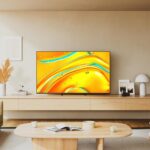
Hubble sometimes gets a bad rap as being inferior to the new James Webb Space Telescope. But it’s not inferior, they’re just designed to view different things in the cosmos. A spiral galaxy 29 million light-years from Earth showcases their different abilities.
The European Space Agency (ESA) released two views of galaxy IC 5332, found in the Sculptor constellation and at 66 million light-years across is about two-thirds the size of the Milky Way. This galaxy is known for being almost perfectly face-on from Earth’s vantage point, making its symmetrical sweeping arms easy to see.
The legendary Hubble telescope, which mostly views visible light and is managed by a partnership between NASA and ESA, shows dark lanes between the dust, allowing the spiral shape to pop against the blackness of space. The Webb telescope, a collaboration of NASA, ESA, and the Canadian Space Agency, was able to detect infrared light waves (a type of light that isn’t visible to our eyes) through that dust, showing a complex star-spangled gas structure, mirroring the same spiral shape. Each arm appears hairier and fibrous, with intricate threadlike features.
The views are different because Webb and Hubble view different types of light, and different stars shine brighter at distinct wavelengths of light. That means scientists can learn a lot about the celestial region from studying both images.
« Ultraviolet and visible light are far more prone to being scattered by interstellar dust than infrared light, » according to ESA. « Therefore dusty regions can be identified easily in the Hubble image as the darker regions that much of the galaxy’s ultraviolet and visible light has not been able to travel through. Those same dusty regions are no longer dark in the Webb image, however, as the mid-infrared light from the galaxy has been able to pass through them. »
Want more science and tech news delivered straight to your inbox? Sign up for Mashable’s Top Stories newsletter today.

Observing mid-infrared light is particularly hard from Earth because the atmosphere absorbs much of it and heat from the atmosphere further complicates detecting this light. Hubble, which resides in low-Earth orbit at some 340 miles above the surface, doesn’t get cold enough to pick up such things.
Webb will observe some of the oldest, faintest light in the universe. The infrared telescope became operational in July 2022.
It uses a much larger primary mirror and is situated in deep space about 1 million miles from Earth.





